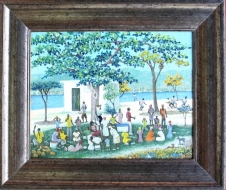Albert Huie was born in Falmouth, Jamaica on December 31, 1920. Huie knew his destiny at an early age, as he began doodling with charcoal, from his grandmother’s old coal stove, on the floor and walls of his Falmouth home.
While his family’s desire was for him to become a teacher, it was his grandmother Sarah alone, who, having recognized his talent was resolute in standing behind him to pursue his life dream of becoming an artist. She aided him monetarily to strike out on his own and told him to go to Kingston, the capital city. This he did at the age of 16, where he soon began honing his craft by painting on fine china and glass. There is an amusing parallel here as, unbeknownst to Huie, the great Impressionist painter Renoir also began his career as a professional china painter.
During this period, Huie took the paintings and sketches he had done around the streets of Kingston and showed them to K. Delves Molesworth, then Secretary of the Institute of Jamaica, who instantly recognized the raw talent in front of him. Molesworth encouraged him to paint professionally and further along commissioned Huie to paint portraits of his family. Very soon it became the fashion for the upper class to have their portraits painted by Albert Huie. His impeccable use of light, whilst observing and painting people in the early years, was often likened to the works of the great masters of Impressionism. One such patron one day suggested to Huie that she would like him to paint in a landscape as the background for her daughter’s portrait.
This led Huie into his greatest love of all, the study of nature and the brilliant Jamaican sunlight, and how it affects everything around it. His eyes see beauty in all things, and light and colour held a peculiar fascination for him. One art critic in Jamaica went as far as to describe him as ‘only’ a colourist. Huie says:”There can be no hard and fast rule for colour in nature, because it is controlled by light. The type of cloud, for example, through which the light filters, and many other changing variables. The most conclusive evidence of light in terms of colour, is that colour at night is different from colour in the day, but the variations during the day are not only of colour…..sometimes the mountains vary in form and texture, sometimes grainy, sometimes wooly, sometimes flat”.
It all has to do with the eye and keen observation. His work stands squarely in the Figurative camp and he makes no apologies for this. Fueled by this fascination, Huie found the scenery in Jamaica inspiring, and has traversed the length and breadth of the island dutifully recording it’s landscape. His Landscapes, Portraits, Figure Compositions, and Still Life paintings all embrace the tactical use of light, which has been his life-long struggle.
In 2001, Huie received his greatest acclaim: the publication of the first book on his life and work. Written by the internationally renowned author, historian, curator, art critic, and photographer, Edward Lucie-Smith, it is titled: ALBERT HUIE: FATHER OF JAMAICAN PAINTING. This book spans six decades of his work and covers five genres. Thus it is that his grandmother Sarah’s dream was not all that farfetched. He, through his work, has taught many to see the beauty inherent in whatever he has carefully observed and captured on canvas.
Huie has shown in many exhibitions, in many countries of the world, and he has earned an international reputation, as his work is represented in many private collections worldwide. There is a story behind every image.





